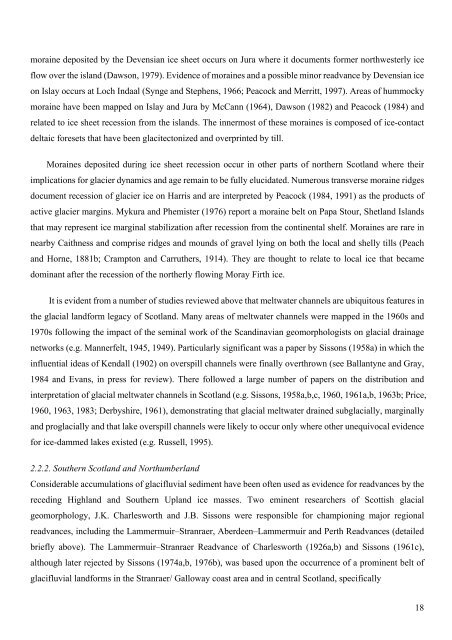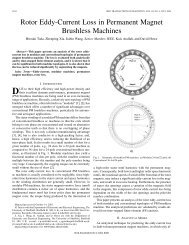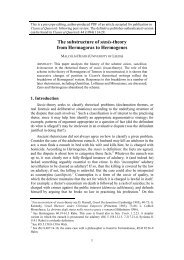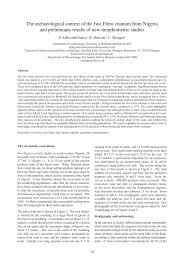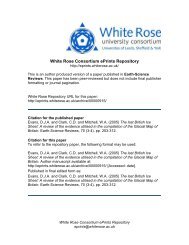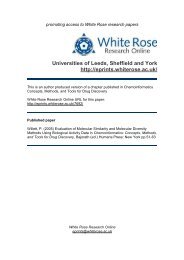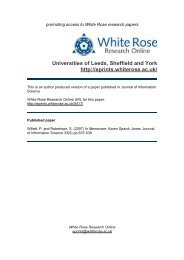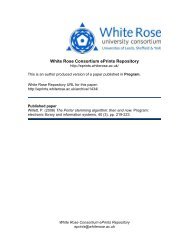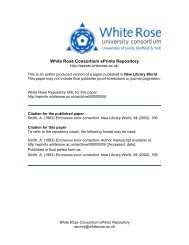The last British Ice Sheet: A review of the evidence utilised in the ...
The last British Ice Sheet: A review of the evidence utilised in the ...
The last British Ice Sheet: A review of the evidence utilised in the ...
You also want an ePaper? Increase the reach of your titles
YUMPU automatically turns print PDFs into web optimized ePapers that Google loves.
mora<strong>in</strong>e deposited by <strong>the</strong> Devensian ice sheet occurs on Jura where it documents former northwesterly ice<br />
flow over <strong>the</strong> island (Dawson, 1979). Evidence <strong>of</strong> mora<strong>in</strong>es and a possible m<strong>in</strong>or readvance by Devensian ice<br />
on Islay occurs at Loch Indaal (Synge and Stephens, 1966; Peacock and Merritt, 1997). Areas <strong>of</strong> hummocky<br />
mora<strong>in</strong>e have been mapped on Islay and Jura by McCann (1964), Dawson (1982) and Peacock (1984) and<br />
related to ice sheet recession from <strong>the</strong> islands. <strong>The</strong> <strong>in</strong>nermost <strong>of</strong> <strong>the</strong>se mora<strong>in</strong>es is composed <strong>of</strong> ice-contact<br />
deltaic foresets that have been glacitectonized and overpr<strong>in</strong>ted by till.<br />
Mora<strong>in</strong>es deposited dur<strong>in</strong>g ice sheet recession occur <strong>in</strong> o<strong>the</strong>r parts <strong>of</strong> nor<strong>the</strong>rn Scotland where <strong>the</strong>ir<br />
implications for glacier dynamics and age rema<strong>in</strong> to be fully elucidated. Numerous transverse mora<strong>in</strong>e ridges<br />
document recession <strong>of</strong> glacier ice on Harris and are <strong>in</strong>terpreted by Peacock (1984, 1991) as <strong>the</strong> products <strong>of</strong><br />
active glacier marg<strong>in</strong>s. Mykura and Phemister (1976) report a mora<strong>in</strong>e belt on Papa Stour, Shetland Islands<br />
that may represent ice marg<strong>in</strong>al stabilization after recession from <strong>the</strong> cont<strong>in</strong>ental shelf. Mora<strong>in</strong>es are rare <strong>in</strong><br />
nearby Caithness and comprise ridges and mounds <strong>of</strong> gravel ly<strong>in</strong>g on both <strong>the</strong> local and shelly tills (Peach<br />
and Horne, 1881b; Crampton and Carru<strong>the</strong>rs, 1914). <strong>The</strong>y are thought to relate to local ice that became<br />
dom<strong>in</strong>ant after <strong>the</strong> recession <strong>of</strong> <strong>the</strong> nor<strong>the</strong>rly flow<strong>in</strong>g Moray Firth ice.<br />
It is evident from a number <strong>of</strong> studies <strong>review</strong>ed above that meltwater channels are ubiquitous features <strong>in</strong><br />
<strong>the</strong> glacial landform legacy <strong>of</strong> Scotland. Many areas <strong>of</strong> meltwater channels were mapped <strong>in</strong> <strong>the</strong> 1960s and<br />
1970s follow<strong>in</strong>g <strong>the</strong> impact <strong>of</strong> <strong>the</strong> sem<strong>in</strong>al work <strong>of</strong> <strong>the</strong> Scand<strong>in</strong>avian geomorphologists on glacial dra<strong>in</strong>age<br />
networks (e.g. Mannerfelt, 1945, 1949). Particularly significant was a paper by Sissons (1958a) <strong>in</strong> which <strong>the</strong><br />
<strong>in</strong>fluential ideas <strong>of</strong> Kendall (1902) on overspill channels were f<strong>in</strong>ally overthrown (see Ballantyne and Gray,<br />
1984 and Evans, <strong>in</strong> press for <strong>review</strong>). <strong>The</strong>re followed a large number <strong>of</strong> papers on <strong>the</strong> distribution and<br />
<strong>in</strong>terpretation <strong>of</strong> glacial meltwater channels <strong>in</strong> Scotland (e.g. Sissons, 1958a,b,c, 1960, 1961a,b, 1963b; Price,<br />
1960, 1963, 1983; Derbyshire, 1961), demonstrat<strong>in</strong>g that glacial meltwater dra<strong>in</strong>ed subglacially, marg<strong>in</strong>ally<br />
and proglacially and that lake overspill channels were likely to occur only where o<strong>the</strong>r unequivocal <strong>evidence</strong><br />
for ice-dammed lakes existed (e.g. Russell, 1995).<br />
2.2.2. Sou<strong>the</strong>rn Scotland and Northumberland<br />
Considerable accumulations <strong>of</strong> glacifluvial sediment have been <strong>of</strong>ten used as <strong>evidence</strong> for readvances by <strong>the</strong><br />
reced<strong>in</strong>g Highland and Sou<strong>the</strong>rn Upland ice masses. Two em<strong>in</strong>ent researchers <strong>of</strong> Scottish glacial<br />
geomorphology, J.K. Charlesworth and J.B. Sissons were responsible for champion<strong>in</strong>g major regional<br />
readvances, <strong>in</strong>clud<strong>in</strong>g <strong>the</strong> Lammermuir–Stranraer, Aberdeen–Lammermuir and Perth Readvances (detailed<br />
briefly above). <strong>The</strong> Lammermuir–Stranraer Readvance <strong>of</strong> Charlesworth (1926a,b) and Sissons (1961c),<br />
although later rejected by Sissons (1974a,b, 1976b), was based upon <strong>the</strong> occurrence <strong>of</strong> a prom<strong>in</strong>ent belt <strong>of</strong><br />
glacifluvial landforms <strong>in</strong> <strong>the</strong> Stranraer/ Galloway coast area and <strong>in</strong> central Scotland, specifically<br />
18


